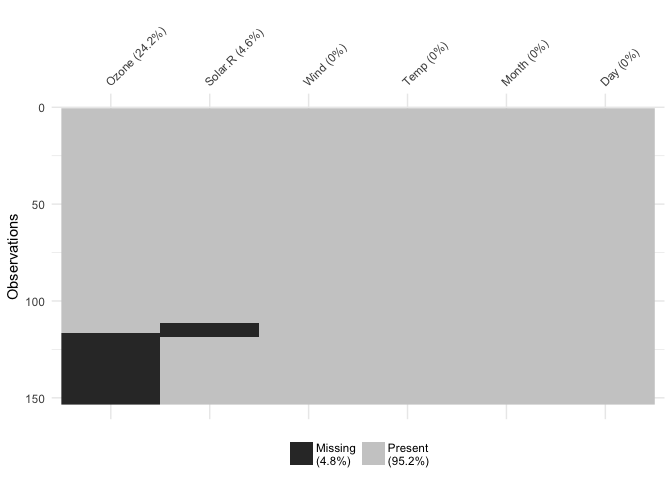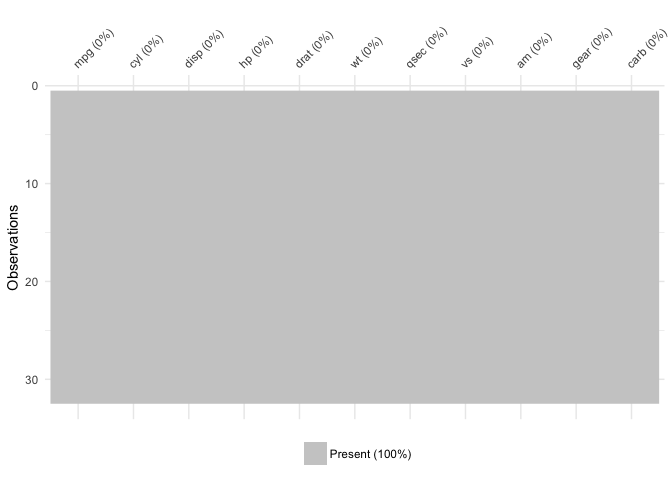visdat is available on CRAN
install.packages("visdat")If you would like to use the development version, install from github with:
# install.packages("devtools")
devtools::install_github("ropensci/visdat")Initially inspired by csv-fingerprint, vis_dat helps you visualise a dataframe and "get a look at the data" by displaying the variable classes in a dataframe as a plot with vis_dat, and getting a brief look into missing data patterns using vis_miss.
The name visdat was chosen as I think in the future it could be integrated with testdat. The idea being that first you visualise your data (visdat), then you run tests from testdat to fix them.
There are two main commands in the visdat package:
-
vis_dat()visualises a dataframe showing you what the classes of the columns are, and also displaying the missing data. -
vis_miss()visualises just the missing data, and allows for missingness to be clustered and columns rearranged.vis_miss()is similar tomissing.pattern.plotfrom themipackage. Unfortunatelymissing.pattern.plotis no longer in themipackage (as of 14/02/2016).
You can read more about visdat in the vignette, "using visdat".
There are also experimental functions, which include guessing values, comparing two dataframes, and adding interactivity. These are described in detail in the vignette "Experimental Features of visdat".
Please note that this project is released with a Contributor Code of Conduct. By participating in this project you agree to abide by its terms.
Let's see what's inside the airquality dataset from base R, which contains information about daily air quality measurements in New York from May to September 1973. More information about the dataset can be found with ?airquality.
library(visdat)
vis_dat(airquality)The plot above tells us that R reads this dataset as having numeric and integer values, with some missing data in Ozone and Solar.R. The classes are represented on the legend, and missing data represented by grey. The column/variable names are listed on the x axis.
By default, vis_dat sorts the columns according to the type of the data in the vectors. You can turn this off by setting sort_type = FALSE.
vis_dat(airquality,
sort_type = FALSE)To demonstrate what visdat looks like when you have different kinds of data, we can look at the dataset typical_data, provided within visdat, and created with the excellent wakefield package.
vis_dat(typical_data)We can also look into using even wider data, looking at typical_larger_data
vis_dat(typical_data_large)We can explore the missing data further using vis_miss().
vis_miss(airquality)The percentages of missing/complete in vis_miss are accurate to 1 decimal place.
You can cluster the missingness by setting cluster = TRUE.
vis_miss(airquality,
cluster = TRUE)The columns can also just be arranged by columns with most missingness, by setting sort_miss = TRUE.
vis_miss(airquality,
sort_miss = TRUE)vis_miss indicates when there is a very small amount of missing data at <0.1% missingness.
test_miss_df <- data.frame(x1 = 1:10000,
x2 = rep("A", 10000),
x3 = c(rep(1L, 9999), NA))
vis_miss(test_miss_df)vis_miss will also indicate when there is no missing data at all.
vis_miss(mtcars)Thank you to Ivan Hanigan who first commented this suggestion after I made a blog post about an initial prototype ggplot_missing, and Jenny Bryan, whose tweet got me thinking about vis_dat, and for her code contributions that removed a lot of errors.
Thank you to Hadley Wickham for suggesting the use of the internals of readr to make vis_guess work.
Thank you to Miles McBain for his suggestions on how to improve vis_guess. This resulted in making it at least 2-3 times faster.
Thanks to Carson Sievert for writing the code that combined plotly with visdat, and for Noam Ross for suggesting this in the first place.
Finally thank you to rOpenSci and it's amazing onboarding process, this process has made visdat a much better package, thanks to the editor Noam Ross (@noamross), and the reviewers Sean Hughes (@seaaan) and Mara Averick (@batpigandme).











